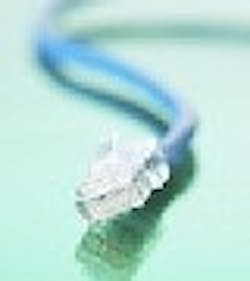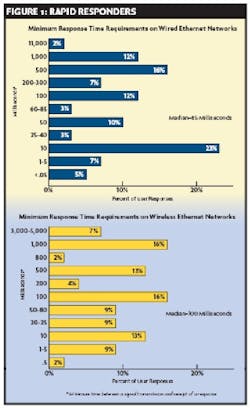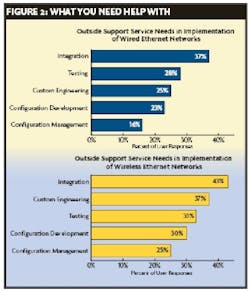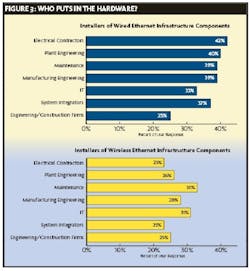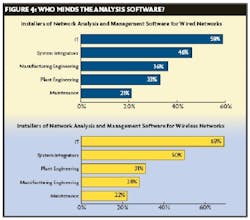Perceptions and realities of Ethernet use: Part 2
For Wired-Networking Components:
Price (31%)
Quality/Reliability (31%)
Being Industrial-Grade (29%)
Ease of Installation/Connection/Configuration (11%)
Ease of Use (10%)
For Wired-Network Analysis & Management Software:
Ease of Use (50%)
Price (44%)
Reliability (11%)
Diagnostic Capabilities (6%)
For Wireless Access Point/Networking Components:
Price (46%)
Reliability (32%)
Security Features (21%)
Being Industrial-Grade (14%)
Range (13%)
For Wireless Network Analysis & Management Software:
Price (50%)
Ease of Use (31%)
Reliability (19%)
Ease of Installation/Configuration (17%)
Diagnostic Capabilities (13%)
Design and performance considerations aside, there’s still the issue of who installs the products. Electrical contractors were cited the most as installers of the wireline Ethernet infrastructure hardware. However, a number of internal user departments were cited almost as often, as were system integrators. User maintenance departments were cited the most often as installers of the wireless Ethernet infrastructure hardware, followed by user IT departments. Figure 3 details these findings. (Click the Download Now button below to view a .pdf version of all charts and tables referred to in this article.)
Wireless Users ID Interference and Security Issues
Signal integrity is a big concern to users and potential users of wireless Ethernet networks in industrial facilities. The interference problems most cited were identified as:
- Interference from other wireless networks/products such as cell phones and other wireless LANs or networks operating in the vicinity
- Transmissions causing problems with other equipment
- RF interference from many types of devices operating in the spectrum being used or generating noise
- Signal blockage and multi-path disturbances due to walls, ceilings, buildings, equipment and metal structures
The most cited means to prevent or overcome interference problems can be summarized as:
- Add access points, antennas, and repeaters to provide better coverage
- Carefully choose type and size of antennas; e.g., directional or omni as appropriate for the site to give optimal coverage and to minimize interference
- Select channels to minimize interference
- Conduct antenna site surveys to ensure good signal reception coverage
- Employ contractors skilled in RF technology to perform the installations
- Increase transmission power where possible
- Limit transmission distances where signals create problems for other equipment
- Provide loss-of-signal alarms
- Reduce sources of RF interference if possible
- Shift to a higher frequency band (IEEE 802.11a at 5 Ghz) where there are fewer interference sources.
Security of wireless signal transmissions is a big concern regarding unauthorized persons — within or outside the facility--being able to receive and use the data. Security of wireless signal receptions is of equal concern, as receipt of unauthorized transmissions--again from within or outside the facility — appearing to be legitimate signals can result in serious consequences.
Wireless Ethernet users most identified a need for software to provide security protection by requiring log-on access codes with frequent code changes and encryption of signals. Some of the same means identified for prevention and solving interference problems also were cited as being applicable to improving security:
- Careful choice in type and size of antennas — i.e., directional or omni as appropriate for the site to give optimal coverage where desired, but to minimize coverage elsewhere.
- Conduct antenna site surveys to ensure good signal reception coverage where desired, and to minimize coverage elsewhere.
- Employ contractors skilled in RF technology to perform the installations.
- Limit power to prevent reception of signals outside the desired coverage area.
| About the Authors |
(Click the Download Now button below to view a .pdf version of all charts and tables referred to in this article.)
